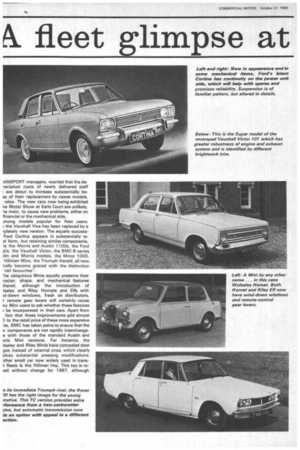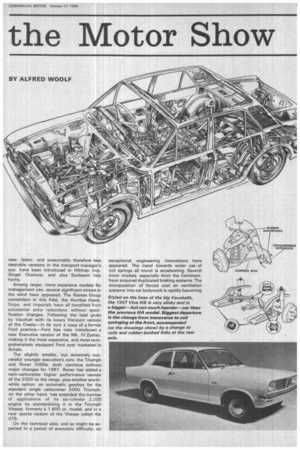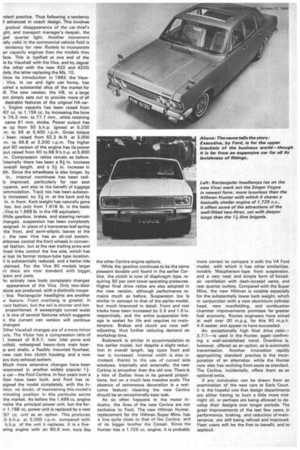k fleet glimpse at the Motor Show
Page 96

Page 97

Page 98

If you've noticed an error in this article please click here to report it so we can fix it.
BY ALFRED WOOLF
LANSPORT managers, worried that the dereciation costs of newly delivered staff are about to increase substantially base of their replacement by newer models, relax. The new cars now being exhibited he Motor Show at Earls Court are unlikely, le main, to cause new problems, either on financial or the mechanical side.
tmong models popular for fleet users, the Vauxhall Viva has been replaced by a lpletely new version. The equally successFord Cortina appears in substantially reId form, but retaining similar components, le the Morris and Austin 1100s, the Ford jlia, the Vauxhall Victor, the B MC B-series ;tin and Morris models, the Minor 1000, Hillman Minx, the Triumph Herald. all now nally become graced with the distinction 'old favourites".
he ubiquitous Minis equally preserve their 'racier, shape, and mechanical features iltered, although the introduction of Iseley and Riley Hornets and Elfs with Id-down windows, fresh air distributors, remote gear levers will certainly cause fly Mini users to ask whether these features be incorporated in their cars. Apart from fact that these improvements pdd almost to the retail price of these more expensive BM C has taken pains to ensure that the components are not rapidly interchangee with those of the standard Austin and irris Mini versions. For instance, the Iseley and Riley Minis have concealed door gas instead of external ones, which clearly olves substantial pressing modifications. )ther small car now widely used in transt fleets is the Hillman Imp. This too is reied without change for 1967, although new, faster, and presumably therefore less desirable versions in the transport manager's eye. have been introduced in Hillman Imp, Singer Chamois, and also Sunbeam Imp forms.
Among larger, more expensive models for management use, several significant straws in the wind have appeared. The Rootes Group contenders in this field, the Humber Hawk, Snipe, and Imperials have all benefited from substantial price reductions without specification changes. Following the lead given by Vauxhall with its luxury Viscount version of the Cresta—in its turn a copy of a former Ford practice—Ford has now introduced a new Executive version of the Mk. IV Zodiac, making it the most expensive, and most comprehensively equipped Ford ever marketed in Britain.
The slightly smaller, but extremely successful younger executive's cars, the Triumph and Rover 2000s, both continue without major changes for 1967. Rover has added a twin-carburetter higher performance version of the 2000 to the range. plus another worthwhile option, an automatic gearbox for the standard single carburetter 2000. Triumph, on the other hand, has extended the number of applications of its six-cylinder 2,000 engine by standardizing it in the Triumph Vitesse, formerly a 1,600 cc. model, and in a new sports version of the Vitesse called the GT6.
On the technical side. and as might be expected in a period of economic difficulty, no exceptional engineering innovations have appeared. The trend towards wider use of coil springs all round is accelerating. Several more models, especially from the Continent, have acquired duplicated braking systems. The incorporation of forced cool air ventilation systems into car bodywork is rapidly becoming ndard practice. Thus following a tendency II advanced in coach design. This involves gradual disappearance of the car-thief's ght. and transport manager's despair, the ed quarter light. Another movement :ally valid in the commercial vehicle field is tendency for new anode's to incorporate ier capacity engines than the models they lace. This is typified at one end of the le by Vauxhall with the Viva, and by Jaguar the other with the new 420 and 4200 dels, the latter replacing the Mk. 10.
;ince its introduction in 1963, the Vaux I Viva, in car and light van forms, has luired a substantial slice of the market for ?If. The new version, the I-1B, to a large ant simply sets out to provide more of all desirable features of the original HA %fern. Engine capacity has been raised from 157 cc. to 1,159 cc. by increasing the bore n 74.3 mm. to 77.7 mm., while retaining same 61 mm. stroke. Power output has le up from 50 b.h.p. (gross) at 5,200 m. to 56 at 5,400 r.p.m. Gross torque : been raised from 62.3 lb-ft. at 3,000 m. to 66.8 at 3,200 r.p.m. The higher
.put 90 version of the engine has its power -put raised from 60 to 68.9 b. h.p. at 5,800 in. Compression ratios remain as before.
Externally there has been a 61 in. increase overall length, and a 31 in. increase in ith. Since the wheelbase is also longer, by in., internal roominess has been radily improved, particularly for rear seat 3upants, and also to the benefit of luggage :ornmodation. Track too has been substanly increased, by 3i in. at the back and by in. in front. Kerb weight has naturally gone too. but only from 1,616 lb. in the basic Viva to 1,698 lb. in the H B equivalent.
Nhile gearbox, brakes, and steering remain ;hanged. suspension has been completely esigned. In place of a transverse leaf spring the front, and semi-elliptic leaves at the r. the new Viva has an all-coil system.
shbones control the front wheels in conven nal fashion, but at the rear trailing arms and lined links control the live axle, which has 11.1 lost its former torque-tube type location.
II is substantially reduced, and a better ride claimed. For the Viva 90 models larger nt discs are now standard with bigger_ ipers and pads.
N,n entirely new body completely changes appearance of the Viva. Only two-door sions are produced, with a distinctly coupe : line. Rectangular headlights are another
.rv feature. Front overhang is greater. in -rent fashion, but the tail is shorter and betproportioned. A sweepingly curved waist 3 is one of several features which suggests
it the current van version will continue changed.
Dther Vauxhall changes are of a more minor lure. The Victor has a compression ratio of I instead of 8.5:1, new inlet ports and inifold, redesigned heavy-duty main bearis and shells, a flexibly mounted flywheel, new cast iron clutch housing, and a new avy duty exhaust system.
Much more extensive changes have been :orporated in another widely popular 1-- e car the Ford Cortina. In four years over a Ilion have been built, and Ford has resigned the model completely, with the in Mon, no doubt, of maintaining this model's minating position in this particular sector the market. As before the 1,499 cc. engine nains the principal power unit, but the for
)r. 1,198 cc. power unit is replaced by a new !97 cc, unit as an option. This produces
.6 b.h.p. at 5,000 r.p.m. compared with b. h.p. of the unit it replaces. It is a fivearing engine with an 80.9 mm. bore like the other Cortina engine options.
While the gearbox continues to be the same pleasant durable unit found in the earlier Cortina, the clutch is now of diaphragm type. requiring 50 per cent lower operating pressures. Higher final drive ratios are also adopted in the new version, although performance remains much as before. Suspension too is similar in concept to that of the earlier model, but much improved in detail. Front and rear tracks have been increased by 2.5 and 1.5 in. respectively, and the entire suspension linkage is sealed for life and requires no maintenance. Brakes and clutch are now selfadjusting, thus further reducing demand on workshop time.
Bodywork is similar in accommodation to the earlier model, but despite a slight reduction in overall length, leg room front and rear is increased. Internal width is also increased, thanks to the use of curved side windows. Internally and externally, the new Cortina is smoother than the old one. There is a hint of Zodiac lines in its general proportions, but on a much less massive scale. The absence of extraneous decoration is a welcome feature; cleaning the new Cortina should be an exceptionally easy task.
As so often happens in the motor industry, the lines of the new Cortina are not exclusive to Ford. The new Hillman Hunter, replacement for the Hillman Super Minx, has a line quite close to that of the Cortina, and of its bigger brother the Corsair. Since the Hunter has a 1,725 cc. engine, it is probably
more correct to compare it with the V4 Ford model, with which it has other similarities, notably Macpherson-type front suspension, and a very neat and simple form of forcedair ventilation with dash-located vents, and rear quarter outlets. Compared with the Super Minx, the new Hillman is notable especially for the substantially lower kerb weight, which in conjunction with a new aluminium cylinder head, new manifolding, and combustion chamber improvements promises far greater fuel economy. Rootes engineers have aimed at well over 30 m.p.g. for this 90 m.p.h. 4-5 seater, and appear to have succeeded.
An exceptionally high final drive ratio3.7:1—is used in the Hunter, again confirming a well-established trend. Overdrive is, however. offered as an option, as is automatic transmission. Another innovation rapidly approaching standard practice is the incorporation of an alternator, while the Hunter now also has reclining front seats as standard. The Cortina, incidentally, offers them as an optional extra.
If any conclusion can be drawn from an examination of the new cars at Earls Court, it is the hopeful one that design departments are either having to burn a little more midnight oil, or perhaps are being allowed to develop their designs over longer periods. The great improvements of the last few years. in performance, braking, and reduction of maintenance, are still being refined and improved. Fleet users will be the first to benefit, and to applaud.












































































































































